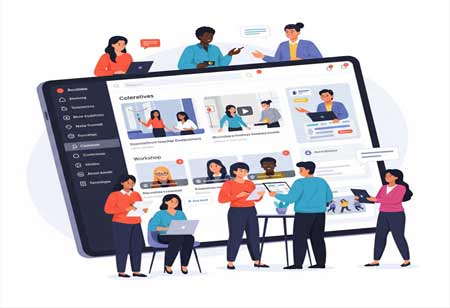THANK YOU FOR SUBSCRIBING
Be first to read the latest tech news, Industry Leader's Insights, and CIO interviews of medium and large enterprises exclusively from Education Technology Insights
The Enrollment Paradox: How Technology Is Reshaping Student Enrollment
Applying to school once meant wading through endless paperwork, deciphering deadlines, and waiting weeks—sometimes months—for a response

By
Education Technology Insights | Thursday, April 17, 2025
Stay ahead of the industry with exclusive feature stories on the top companies, expert insights and the latest news delivered straight to your inbox. Subscribe today.
Applying to school once meant wading through endless paperwork, deciphering deadlines, and waiting weeks—sometimes months—for a response. It tested patience as much as merit. Fast-forward to 2025, and the student enrollment process has radically transformed. Schools, colleges, and universities—once slow to embrace digital change—now operate with the precision of customer-centric enterprises, leveraging artificial intelligence, automation, and predictive analytics to engage prospective students.
This shift isn’t just about efficiency—it’s about survival. Institutions face a perfect storm: declining birth rates (Japan’s under-18 population has shrunk by 25 percent since 2000; South Korea’s fertility rate sits at 0.78), skyrocketing tuition (U.S. college costs have risen 169 percent since 1980), and fierce global competition (India now graduates 1.5 million engineers annually, compared to 300,000 in the U.S.). To stay competitive, universities borrow tactics from e-commerce, treating enrollment less as an administrative task and more as a high-stakes conversion funnel. Every click, inquiry, and abandoned application is a data point in an increasingly sophisticated enrollment strategy designed to optimize yield.
The Machinery Behind Modern Enrollment AI-Powered
Concierges Chatbots like AdmitHub—used by Georgia State to boost enrollment by 24 percent—now handle 80 percent of applicant queries in real-time. These AI-driven assistants manage everything from visa paperwork to dorm selection, using natural language processing to mimic human empathy. If a student abandons an application, machine learning algorithms trigger a personalized video message from an alumnus within minutes.
Predictive Analytics Warfare
Platforms like Salesforce Education Cloud process terabytes of data—social media engagement, email open rates, even Wi-Fi logins during campus tours—to assign "enrollment probability scores." Universities then hyper-target high-value prospects. Purdue, for example, has used predictive analytics to cut marketing costs by 30 percent.
Dynamic Pricing and Aid
Borrowing from airline yield management, institutions like Northeastern adjust financial aid offers in real-time based on demand. AI-powered tools such as RaiseMe gamify the scholarship process, allowing students to earn tuition credits for academic and extracurricular achievements.
Metaverse Enrollment
Fisk University’s VR campus tours, built on the Unity Engine, have driven a 40 percent increase in international applicants. Students in Mumbai can now attend a Harvard lecture via Meta Quest 3 and interact with admissions officers as avatars.
E-Commerce Strategies
The Common App now functions like Amazon, suggesting that "Students Who Applied to X Also Liked Y." Abandoned applications trigger remarketing campaigns, and Arizona State follows up with targeted TikTok ads within hours.
The Results Are Striking
● Speed: 73 percent of institutions now issue admissions decisions in under two weeks, a stark contrast to the 12+ months Ivy League schools took in 2010.
● Yield Rates: AI-driven nudges, such as personalized texts sent when a student engages with a rival school, have boosted conversions by up to 20 percent at Big Ten institutions.
● Globalization: AI translation tools like DeepL allow universities to auto-localize prospectus materials into 50+ languages, helping UCLA double its Nigerian applicant pool.
The Financial Aid Bottleneck
The most significant hurdle for many students isn’t academic—it’s financial uncertainty. Tuition remains a looming challenge, and complex financial aid applications often deter enrollment. In 2025, institutions are embedding financial aid tools directly into the application process, offering real-time cost breakdowns and AI-powered estimators that clarify funding options.
Some universities have gone further, integrating blockchain-backed credentialing systems for instant scholarship, grant, and loan eligibility verification. This shift reduces paperwork and gives students financial clarity much earlier in the process—before doubt turns into disengagement.
The Privacy Trade-Off
With increased digitization comes a critical tension: data privacy and security. Regulations like GDPR in Europe and FERPA in the U.S. set strict limits on student data usage. Still, as institutions embrace AI-driven enrollment, the line between personalization and intrusion blurs.
Admissions offices now access more behavioral data than ever—how long a student lingers on a program page, which emails they open, even which financial aid options they hesitate over. Institutions argue this data enhances the experience, but ethical concerns are growing. Do students fully understand how their data is being used? Should universities infer financial anxiety from browsing patterns and tailor outreach accordingly?
To address concerns, some schools now offer transparency dashboards, allowing applicants to see how their data informs admissions decisions. Others are exploring decentralized identity solutions, giving students greater control over their credentials and limiting unnecessary data sharing.
What’s Next?
As enrollment strategies evolve, the next frontier is immersive and autonomous admissions. Virtual reality campus tours are shifting from novelty to necessity, letting students explore campuses from their phones or headsets. AI-driven admissions counselors—digital avatars trained on thousands of interactions—are beginning to replace traditional call centers. Blockchain-based transcripts and credentialing systems could one day make the entire application process as seamless as a tap on a screen.
Yet, one truth remains unchanged despite all technological advancements: choosing a school is deeply personal. No algorithm, chatbot, or predictive model can fully capture the weight of that decision. The best institutions of 2025 understand this. They are using technology not to replace human connection but to enhance it—to remove obstacles, simplify choices, and make the path to education as inviting as possible.
The future of enrollment isn’t just about speeding up the process. It’s about making it feel like the beginning of something extraordinary.







